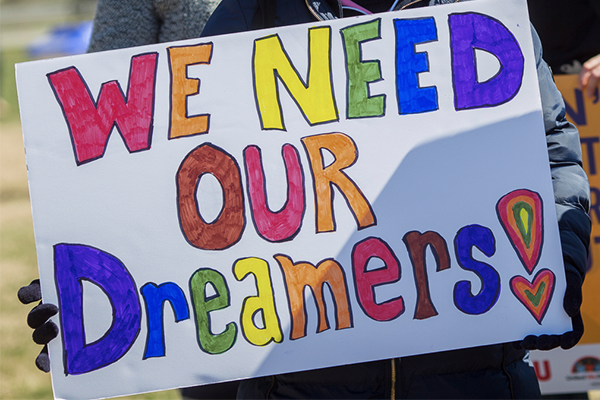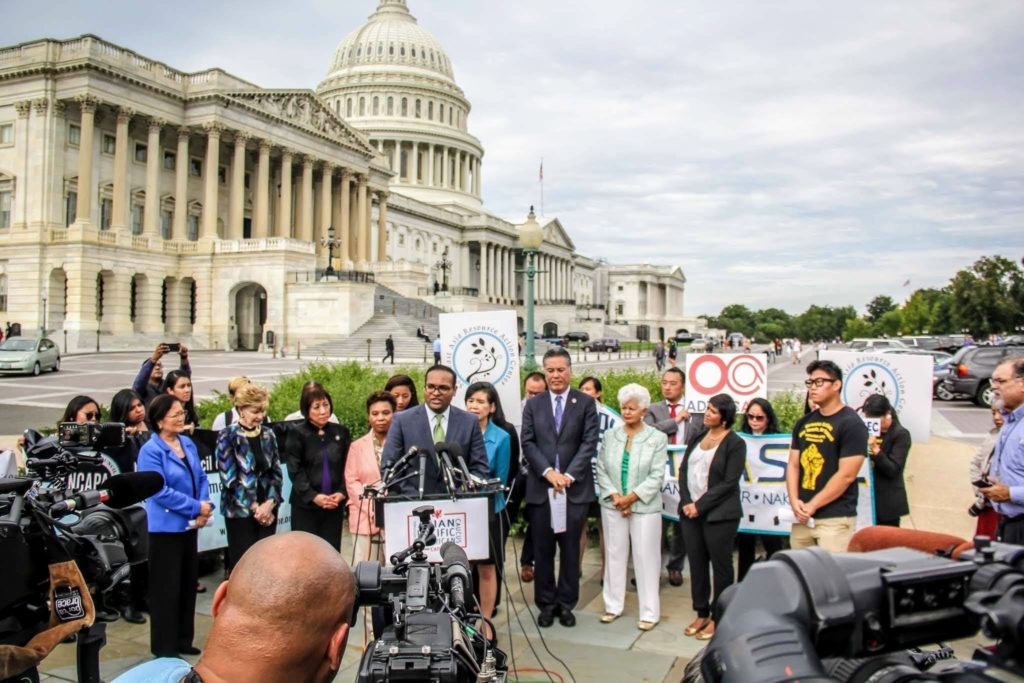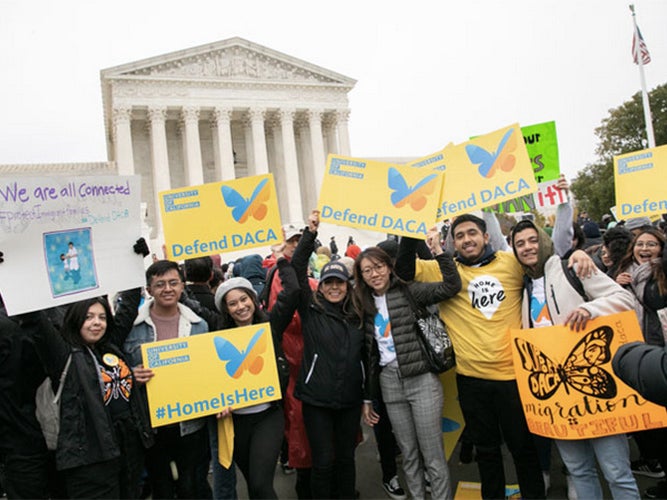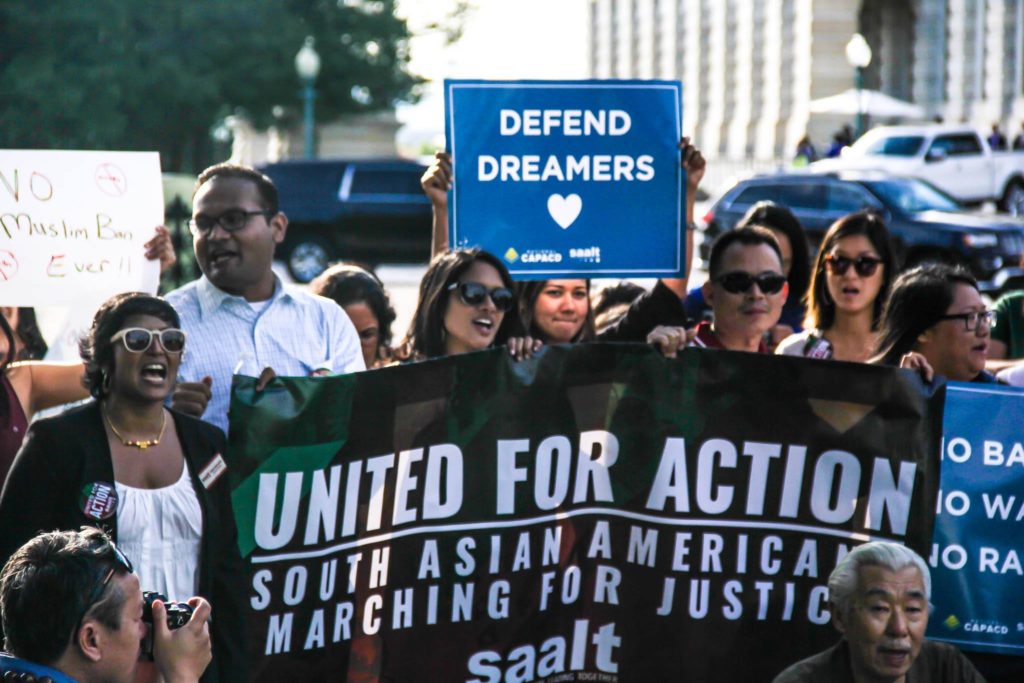3428 people reached on Lassi with Lavina FB page – 759 engagements – FB Insights
259 views on Linkedin – 5 Likes
DACA protest – SAALT
The US Supreme Court Ruling Allows Dreamers to Keep Dreaming – for the time being
Indian undocumented youth are also part of the DACA story
[dropcap]R[/dropcap]ecently Americans have been facing bad news, be it about the unending coronavirus crisis, the failing economy or the scourge of racism and police brutality against blacks and other minorities. In this area of darkness comes a spot of brightness in the Supreme Court’s stunning move against the Trump administration’s effort to end the Deferred Action for Childhood Arrivals (DACA) program, which shields some young undocumented immigrants from deportation.
In a reprieve for the Dreamers, as they are known, the U.S. Supreme Court issued a decision finding that the Trump administration’s termination of DACA was judicially reviewable and done in an arbitrary and capricious way that violated federal law.
At a time when all is gloom and doom on the immigration front, this is a cause for some celebration. The Dreamers came to America as children of undocumented immigrants, some as young as two years old. Many don’t even remember any other home. They are now in their 20’s and 30’s; they have gone to school here, found jobs, some have got married and even have children of their own.
Yet they have been living this assumed life on a roller-coaster, not knowing when their ride will end. They happen to be the children of undocumented workers who have lived their lives in the shadows, and that may have been their fate too – had it not been for an executive action taken when Barack Obama was president by which the U.S. Department of Homeland Security (DHS) announced that it would not deport certain undocumented youth who came to the United States as children. The Deferred Action for Childhood Arrivals or DACA created a whole new world for these children who through no fault of theirs were in this predicament.

[dropcap].C[/dropcap]hirayu Patel, a Dreamer whom I had connected with in 2017, told me: “For many of us so called “Dreamers,” we only know America as our home. I came here at the age of 11, and have met other Indian-American Dreamers that have been here since they were toddlers as young as 2 years old. We are hopeful that political leaders in Washington realize this soon and come up with a permanent solution.”
As he recalls, the introduction of DACA in 2012 was a consequential day for him, allowing him to start building a foundation in America. The rescinding of DACA by President Trump had a big effect: he recalls, “It was a punch in the gut, and I felt the floor disappear under my feet.”

[dropcap]A[/dropcap]ccording to Pew Center research, there are 649,000 DACA enrollees, the majority from Mexico and the Caribbean but also enrollees from Asia (3 % ) with children from South Korea, Philippines and India. They are in all 50 states but about 50 % are in California, Texas, Illinois, Florida, North Carolina and New York.
Those enrolled in DACA were able to get college education, jobs and build a life of their own. Today many are essential workers working their hearts out in the COVID crisis, others are studying at American universities and still others are serving in the military.
The New York Times notes that the program has been life-changing for more than just direct participants: Some 250,000 U.S.-born children have at least one parent who is a DACA beneficiary. All told, about 1.5 million people in the United States live with someone who is protected from deportation solely because of the program.
While DACA gave these children a new life in the Obama years, the program was in jeopardy when Donald Trump took office and terminated the program. Multiple federal courts then ruled the administration must continue to accept renewal applications.
On March 12, 2019, Democrats in the US House of Representatives led by Reps. Lucille Roybal-Allard (CA-40), Nydia Velázquez (NY-07), and Yvette Clarke (NY-09) announced the introduction of the American Dream and Promise Act (ADPA). It passed in the House but is yet to make its way through the Republican controlled Senate.

[dropcap]T[/dropcap]he Dreamers have proved they are an asset to the country. According to American progress.org, 202,500 DACA recipients are working to protect Americans during the COVID-19 crisis, many as doctors and medical students, putting their own health and safety on the line. They are also teachers, giving a sense of well-being and continuity to America’s students remotely. In New York, 9,200 DACA recipients are serving as front line workers. 1,200 of them are healthcare workers.
This recent victory with the Supreme Court decision has given the Dreamers and their families breathing room. Public opinion is largely with them as according to a survey by Pew Research Center, three-quarters of Americans favor granting DACA recipients legal status.
Undocumented Indians also have enrolled in DACA though not to their full capacity as many are afraid to come into the open. Chirayu Patel has been an activist for DACA in Washington DC, and has met with Speaker Nancy Pelosi and other elected officials along with other Dreamers.
He had shared his own story with me, about how his family had come from Gujarat to Chicago, and applied through an “attorney” to become permanent residents. “Initially, my father received a work permit and we thought we were on the right track,” he recalls. “ Later we would learn that he wasn’t an attorney and filed incorrectly through a program that wasn’t a solution. There were many thousands of individuals affected in a similar matter.”
[dropcap]H[/dropcap]e pointed out that the major themes among Indian Americans with DACA is that they came here on a short term visa or crossed the border (Mexico/Canada). All of them were either brought here to reconnect with family members that were already in the US or joined them along due to economic or safety reasons. There are large numbers of undocumented young Indians who would be eligible for DACA but have not applied. This is due to multiple reasons but some common ones are fear of government use of data to track down and deport in the future, or to deport family members, high cost of application and legal fees.
In the DACA roller coaster ride of ups and downs, the Dreamers are again on an upswing for the time being.
“The Supreme Court ruling on DACA shows what we all knew: Trump’s immigration policies are arbitrary, capricious, and just plain stupid. It’s a victory for America’s families, communities, health, and economy,” says Steve Choi, Executive Director, New York Immigration Coalition.
President Trump has not been pleased with the verdict. He tweeted, “The recent Supreme Court decisions, not only on DACA, Sanctuary Cities, Census, and .others, tell you only one thing, we need NEW JUSTICES of the Supreme Court.” So we know the story is far from ended.
As Bitta Mostofi, Commissioner of the Mayor’s Office of Immigrant Affairs, observed, “But we also know that the fight must continue. We call on the Senate to pass the American Dream and Promise Act so that the hundreds of thousands of Dreamers around the country can be on a path to citizenship.”
Democratic presidential candidate Joe Biden has promised to make the DACA ruling permanent on Day One, if he is elected. “For over eight years, DACA has given hundreds of thousands of young immigrants who came to this country as children the chance to contribute to the country they know as home. And with that opportunity, they have shown the incredible capacity of the immigrant spirit.”
President Barack Obama, who had got the Dreamers dreaming by establishing the DACA program through an executive order, responded: “Eight years ago this week, we protected young people who were raised as part of our American family from deportation. Today, I’m happy for them, their families, and all of us. We may look different and come from everywhere, but what makes us American are our shared ideals.”
(This article appeared in my weekly column India in America in CNBCTV18.com)

